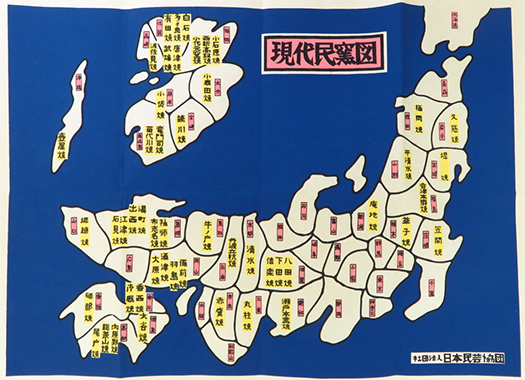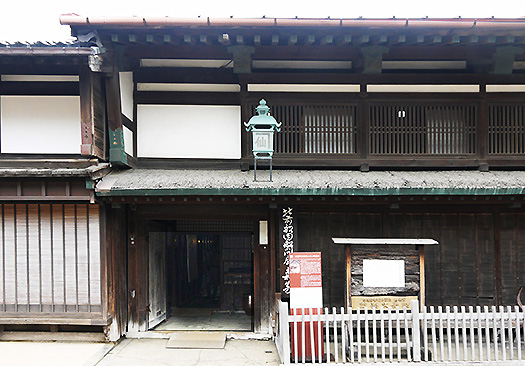

上の図版は日本各地の民藝を紹介するよく知られた全国地図群。
別に悪気があるものでないことは百も承知なのですが、
それでも「民藝」工芸の全国発掘に於いて北海道が除外されていることには
あまり楽しい気分はしない。
民藝運動というものにはるかなリスペクトを持っている者として
この点はやや悲しいなぁと思ってきています。
これについてたぶん日本民藝協会としても議論があって
近年はアイヌ文化について積極的に発掘・称揚されているように思います。
それは喜ばしい面はあるけれど、しかし明治以降の移住開拓民の末裔として
「民藝」創始者の柳宗悦さんの民藝発掘の情熱からきれいに北海道が
除外されていたことには、やむを得ない側面を感じつつ、
北海道人として今後どう考えて行くべきか、ある思いを持っている次第。
わたしは文化運動としての民藝運動には共感は強く持っています。
日本人の暮らし合理性に涵養され育まれてきた美感・感受性への気付き、
その発掘努力には深い敬意を持つところです。
実際に多くの全国の建築を見る中、北海道に繋がる富山の北前交易者の住宅が
民藝運動のスポンサー・大原家によって購入され
床の間には棟方志功の絵が軸装され展示される様子をこのブログでも紹介。


さまざまな職人の手仕事に対する審美眼という視線は深く共感するものです。
こうした取材を通して民藝運動というものの実質をはじめて知ったともいえる。
創始者・柳宗悦さんのポリシーにはものづくりの本質が示されている。
・・・そうであることを知りつつ北海道が空白の民藝地図を見て
わたしたち移住者の営為はどのように考えて行くべきなのか、思い惑う次第。
最近民藝運動にスポットが当たってきている。
東京北の丸公園の東京国立近代美術館で展示会も現在開かれているとのこと。
柳宗悦さん没後60年という節目で開催された。
わたしは駒場の日本民藝館建築見学の経験もあります。
そういった経緯を踏まえながら北海道人として、住宅の取材者として
この柳宗悦さんが始められた民藝運動と北海道移住後150年という
いわば民族の混淆が激しく進行した独特の風土性から
どんな「民藝」がいま、生み出されつつあるのか、
掘り起こしていって見たいと念願しています。
縄文、続縄文、擦文、アイヌ文化と変遷を経てきている北海道島の歴史に踏まえ
この北の島嶼でのものづくりの営為を掘り起こしてみたいと念願する次第。
日本人が暮らし始めて住居建築では本格的に欧米と交流し独自発展させたきた。
年末年始の時期の掘り起こし型ブログ連載記事として
シリーズ的に日本各地との比較文化論的にも考えて見たいところです。
English version⬇
[Ah? There is no Hokkaido on the map (crying) Minge and Hokkaido-1]
The illustration above is a well-known national map that introduces folk art from all over Japan.
I know that it’s not malicious, but
Even so, the fact that Hokkaido is excluded in the nationwide excavation of “folk crafts”
I don’t feel very happy.
As someone who has a great deal of respect for the Mingei movement
I’m feeling a little sad about this point.
There was probably a discussion about this as well as the Japan Folk Art Association.
In recent years, I think that the Ainu culture has been actively discovered and praised.
That’s a good thing, but as a descendant of the migrant pioneers after the Meiji era.
Hokkaido is beautiful from the passion of the founder of “Minbutsu”, Mr. Soetsu Yanagi, to excavate the folk art.
Feeling the unavoidable side of being excluded,
As a Hokkaido person, I have a certain thought about what I should think about in the future.
I have a strong sympathy for the Mingei movement as a cultural movement.
Awareness of the beauty and sensitivity that has been nurtured and nurtured by the rationality of Japanese life,
I have a deep respect for the excavation efforts.
While actually looking at many buildings nationwide, the housing of the Kitamae trader in Toyama, which is also connected to Hokkaido, is
Purchased by the Ohara family, the sponsor of the Mingei movement
In this blog, I also introduced how a picture of Shiko Munakata is displayed on the alcove.
I deeply sympathize with the aesthetics of various craftsmen’s handicrafts.
It can be said that I learned the substance of the Mingei movement for the first time through such interviews.
The policy of the founder, Muneyoshi Yanagi, shows the essence of manufacturing.
… Knowing that, looking at the blank folk art map of Hokkaido
I’m wondering how we migrants should think about their activities.
Recently, the Mingei movement has been spotlighted.
An exhibition is currently being held at the National Museum of Modern Art, Tokyo in Kitanomaru Park, Tokyo.
Muneyoshi Yanagi was held at the milestone of 60 years after his death.
I also have experience in visiting the architecture of the Japan Folk Crafts Museum in Komaba.
Based on such circumstances, as a Hokkaido person, as a housing interviewer
It’s been 150 years since the Mingei movement started by Muneyoshi Yanagi and the move to Hokkaido.
So to speak, because of the unique climate in which ethnic chaos has progressed violently.
What kind of “folk art” is being created now?
I hope to dig up and see it.
Based on the history of Hokkaido Island, which has undergone a transition with Jomon, Zoku-Jomon, Satsumon, and Ainu culture
I hope to dig up the manufacturing activities on this northern island.
Japanese people have begun to live and have developed their own housing architecture by interacting with Europe and the United States in earnest.
As a blog serialized article that digs up during the year-end and New Year holidays
I would like to think about it as a series in terms of cross-cultural comparison with various parts of Japan.
Posted on 12月 29th, 2021 by 三木 奎吾
Filed under: リプラン&事業, 住宅マーケティング, 日本社会・文化研究







コメントを投稿
「※誹謗中傷や、悪意のある書き込み、営利目的などのコメントを防ぐために、投稿された全てのコメントは一時的に保留されますのでご了承ください。」
You must be logged in to post a comment.